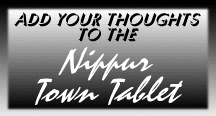Anshe the Enterprising Equid introduces some cattle by name!
Humans sometimes take their non-human helpers for granted. One way to avoid this is to dignify your animal friends with personal names. This is not a new idea. Inhabitants of Old Babylonian Nippur mention the names of certain of their animals. As an enterprising quadruped, I figured our world-wide visitors would like to see examples for themselves. Details of bibliography are given at the end.
In 1781 B.C., in the eleventh month (around the time of your February-March), at Nippur, the four sons of Imgûa partitioned the estate of their (deceased) father. Besides field and house property, equipment and furnishings, the estate included animals, such as sheep. Cattle were also distributed to the sons. These were designated by their personal names! In case you are not sure what names to pick for your cattle, the names are presented here in cuneiform with transliteration and explanation. What names do you think were common among the donkeys?
The share of the eldest son Shallurum included (lines 15-16):

1 gu4 mi-nam-e-pu-uš-AN
1 áb ta-ri-ba-tum
"One ox (by the name of) Mînam-êpuš-ilam
One cow (by the name of) Tarîbatum"
The name of the ox can be interpreted as "What have I done, O God?" and the name of the cow as "Substitute." The cow's name is a feminine rather than masculine name.
The share of the second son Apiyatum included (lines 33-34):

1 áb ì-lí-dum-qí
1 áb EŠ4.DAR-ri-im-ti-ì-lí
"One cow (by the name of) Ilî-dumqî
One cow (by the name of) Ishtar-rîmti-ilî"
The name of the first cow can be interpreted as "My (personal) god is my good fortune!" and the name of the second cow as "Ishtar is the wild cow of the gods!". (On the second name, notice that AHw derives the Akkadian word rîmtu differently and suggests "Ishtar is the beloved of the gods!").
The share of the third son Siyatum included (line 53):

1 gu4 puzur4-dlugal-bàn-da
"One ox (by the name of) Puzur-Lugalbanda
This name can be interpreted as "Security of (the god) Lugal-banda!", as an expression of trust or hope to be under the protection of the deity.
The share of the fourth son Lugatum included (lines 71-72):

1 áb dnin-sún-la-ma-sí
1 gu4 dnin-šubur-ba-ni
"One cow (by the name of) Ninsun-lamassî
One ox (by the name of) Ninshubur-bâni"
The name of the cow can be interpreted as "Ninsun is my protective spirit!" and the name of the ox as "Ninshubur is my creator."
Bibliography
The cuneiform tablet is housed in the Iraq Museum and was published by J.J.A. van Dijk, Old Babylonian Contracts and Juridical Texts, Vol. 4 Texts in the Iraq Museum. Wiesbaden, 1967. Text No. 1.
The text is treated in detail, along with related texts, by Erwin Prang, "Das Archiv des Imgûa," Zeitschrift für Assyriologie und vorderasiatische Archäologie, 66 (1976), 1-44. Dr. Prang interprets the names of the cattle (in the above order) as
- Was habe ich getan, o Gott?
- Entschädigung
- Mein Gott ist das Gute für mich
- Istar ist die Wildkuh der Götter
- Geborgenheit des Lugalbanda
- Ninsun ist mein Schutzgeist
- Ilabrat ist Erschaffer
These Akkadian names used for cattle also appear as names of humans. On the subject of personal names in the Akkadian language, see J.J. Stamm, Die Akkadische Namengebung, Vol. 44 Mitteilungen der Vorderasiatisch-Aegyptischen Gesellschaft. Leipzig: J.C. Hinrichs Verlag, 1939.
Click on these links to navigate our site:
- Return to Anshe's Room to learn more about the non-human inhabitants of Nippur.
- To find the most official point of view from the great king, enter the Royal Display Room.
- To see Nippur through the eyes of explorer and excavator John Punnett Peters, first modern archaeologist at Nippur, visit our Earth-Moving Room.
- To help visualize the location and layout of Nippur, visit the Map Room.
- To learn more about ancient Nippur, discover the resources in the Reading Room, or study the bigger picture of cuneiform culture at the Reading Room's Cultural Annex.
- To get an overview of Nippur, go to the Broad Vista Room.
- To evaluate the specialization of labor and professionalism at ancient Nippur, take a look in the Professional Room.
- To sneak up for a close look at "the establishment," step into the Establishment Room.
- After you have wandered through the rooms of Dubsar's abode, try your hand at the Nippur Quiz. JavaScript required. Two levels now available.
- Return to the home page of Dubsar, the Cuneiform Scribe.



This page was edited on 8 May 1999. If you have cuneiform questions or comments, please email Dubsar, the Cuneiform Scribe. If I do not respond promptly, the vendor supplying Fortune City's email service may be eating your mail for lunch. In that case, you can give a shout over to Dubsar's Sand Dune to get my attention. Thanks! © 1998-1999 Erasmus Compositor, P.O. Box 25958, Baltimore, MD 21224.




